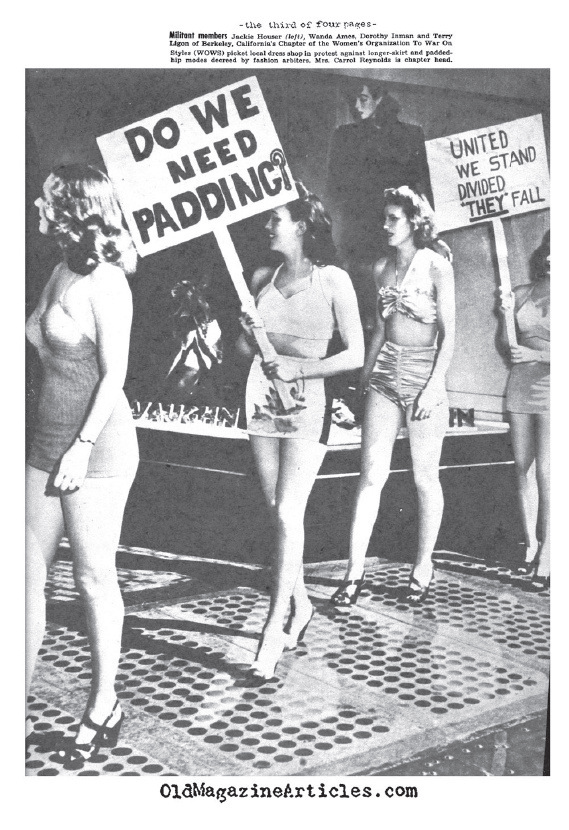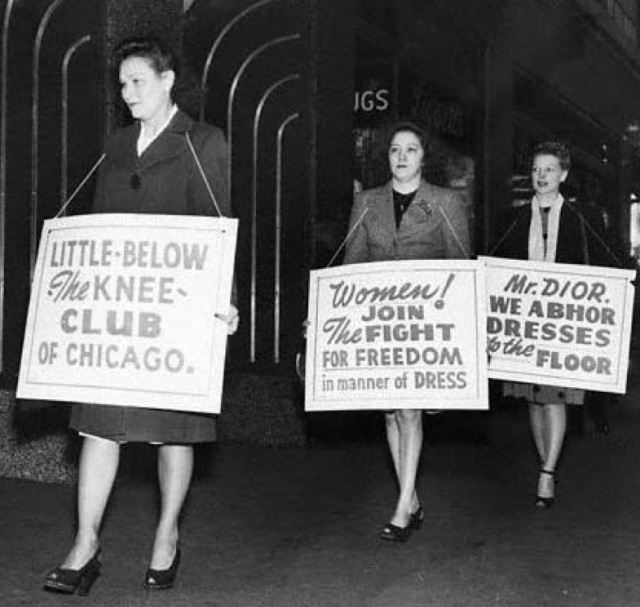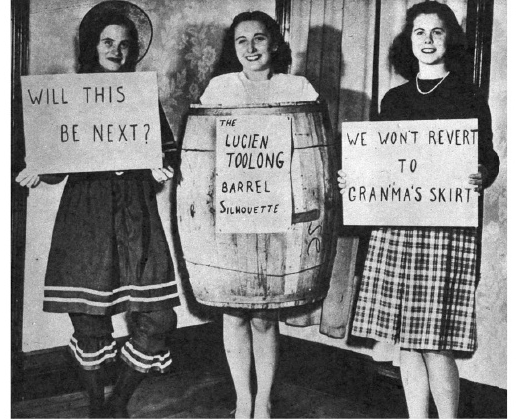There’s never anything in this world that everyone loves.
Whenever you see talk of Dior’s “New Look” arriving post war in 1947 it often comes attached to the idea that after the privations of the war women were all delirious to fling off their utilitarian clothing and prance around in petticoats and corsets again.
But as with anything there was always an opposing view. The first protests were shortly after it’s launch. When showing the collection in Montmarte photos of sales girls who ‘leapt forward and tore apart the dresses’ were published in the magazine Paris Match and later the protests became more organised.
The Little Below the Knee Club was formed in August 1947 in Dallas, Texas by ex-model and now housewife Bobbie Woodward and rapidly grew to 1,300 members, with similar clubs springing up all over the country.
I first heard about the Little Below the Knee Club through this picture and then went off to do a little more research.
Mrs Woodward’s reasons for starting the club were primarily economic, she didn’t want to throw away her whole wardrobe, and saw no reason why her husband should pay for her to do so. She also said
‘I thought a lot of women might feel the same way and now I know they do. We are going to wear clothes that look best on us — styles we have a right to choose. Why should a girl cover up her legs—they may be her best selling point.
Other complaints against the “New Look” were fashion based, deriding it as old fashioned, with placards proclaiming “Granma Wore This!” and “We Won’t Revert to Granma’s Skirt”
There were also more serious minded complaints, with some women expressing dismay at the backwards step it represented for the Women’s movement, and focusing on the impractical nature of the skirts, which were highlighted when a lady named Louise Horn in California got her full skirt caught in a bus door and had to run alongside it for a block before being released.

It wasn’t just women that were opposed to the “New Look” either. In Georgia “The League of Broke Husbands” took a strictly economic view of the style and hoped to get ‘30,000 American husbands to hold that hemline’. My all time favourite comment on the controversy, though, has to come from 75 year old Josiah D. Malcomson who, when asked his opinion on Women’s skirt lengths, declared “The shorter the better”.
In the UK, of course, there were more than financial and practicality issues with Diors New Look. Even if you could afford it, fabric was still rationed until 1949. One particular Dior skirt used 17 yards of fabric to make, at 3 coupons a yard one skirt could use over a years coupons. The look was condemned by president of the Board of Trade Sir Stafford Cripps who was appalled at the waste of materials, when Harold Wilson took over his job later in 1947 he simply stated
“If women are going to buy these skirts, they are going to have to buy fewer of them.”
British women who wanted to remain in fashion found it difficult to alter clothing they already had to suit this new style as they had in the past. Many tried by adding gores into slimmer skirts and extra fabric at the waist to lengthen them.
If you believe See magazine then by November 1948 British women were well and truly converted to the New Look, regardless of coupons or financial straits. All thanks to a buyer for a “chain of low-price English stores” stocking the racks with “New Looking frocks”.
Opposition to the New Look didn’t really have much impact, as fashion history surely shows, by the 1950s the longer full skirts of Dior’s New Look had captured the popular imagination and would become the defining style of the 1950s.
Sources: The Courier Mail – Brisbane 19th August 1947, The Reading Eagle 24th August 1947, Ellensburg Daily Record 4th November 1947, ROM Magazine 22nd March 2010, Fashion-era.com, See Magazine January 1948, See Magazine November 1948, The Telegraph 8th March 2011, The Guardian 16th March 2007


Cathy Stevens Carey liked this on Facebook.
Sarah Lawson liked this on Facebook.
Tracey O’Connor liked this on Facebook.
This is so interesting! I had no idea there was opposition to longer length skirts as they were so ubiquitous by the 50s. More historical posts like these please 😀
Great post! I never knew there was such controversy over the New Look.
Wow, how interesting! I feel like there’s a much wider variety of fashion trends nowadays, so it’s hard to even conceive of a new change in fashion that would illicit such a reaction. But it makes so much sense in the historical context of what you talked about.
Anyway, as someone who sews, I do get away with buying a lot less fabric per skirt/dress when I sew pre-New Look patterns and hemlines and that’s a considerable savings that I appreciate. 😉
Oh yes! I remember my mum saying that in the 60s you didn’t get this choice of fashion trends. If short skirts were in that’s what you wore and all you could buy!
Élisabeth von Nymphenburg liked this on Facebook.
Thank you, what an interesting post I love to ready historical information such as this, it helps to understand how we got to where we are today 🙂
peta xx
http://www.petasvintageboutique.com
A fascinating post! Thanks for sharing your research 🙂
How interesting. This is the first I’ve ever heard of this.
Gosh, Gemma this is so fascinating! I had no idea it provoked such a reaction! As a historian and lover of frocks I do love these posts of yours, thanks for putting in the time to research and write them! x
RT @Retrochick_uk: Bit of history for you on a Sunday afternoon, the opposition to Diors New Look in the 40s http://t.co/yWXgeJgues
@Retrochick_uk
Love your blog
RT @Retrochick_uk: Bit of history for you on a Sunday afternoon, the opposition to Diors New Look in the 40s http://t.co/yWXgeJgues
Little Below the Knee Club versus the New Look: http://t.co/cz1IUSM6rF
Little Below The Knee Club – Retro Chick http://t.co/jC17udMXnw http://t.co/4I5In1tvLf
Great post! I too was surprised when I first encountered the first picture. But it totally maks sense! Practical clothes had to make way for unpractical ones that also had to be less comfertable to wear. Not to mention the amount of fabric and the cost of this new look.
Love your blog 🙂